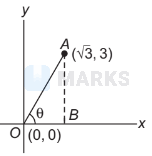Search any question & find its solution
Question:
Answered & Verified by Expert
A particle starting from the origin $(0,0)$ moves in a straight line in the $(x, y)$ plane. Its coordinates at a later time are $(\sqrt{3}, 3)$. The path of the particle makes with the $x$-axis an angle of
Options:
Solution:
2194 Upvotes
Verified Answer
The correct answer is:
$60^{\circ}$
Draw the situation as shown. OA represents the path of the particle starting from origin $O(0,0)$ Draw a perpendicular from point $A$ to x-axis. Let path of the particle makes an angle $\theta$ with the x -axis, then

$\begin{aligned} \tan \theta & =\text { slope of line } O A \\ & =\frac{A B}{O B}=\frac{3}{\sqrt{3}}=\sqrt{3} \\ \text { or } \quad \theta & =60^{\circ}\end{aligned}$

$\begin{aligned} \tan \theta & =\text { slope of line } O A \\ & =\frac{A B}{O B}=\frac{3}{\sqrt{3}}=\sqrt{3} \\ \text { or } \quad \theta & =60^{\circ}\end{aligned}$
Looking for more such questions to practice?
Download the MARKS App - The ultimate prep app for IIT JEE & NEET with chapter-wise PYQs, revision notes, formula sheets, custom tests & much more.